What should I do if I get scalded by hot oil?
Under normal circumstances, burns caused by hot oil can be treated by methods such as rinsing with cool water to reduce temperature, removing clothing from the affected area, wound cleaning, medication, dressing the wound, or leaving the wound exposed. The specific steps are as follows:

1. Rinsing with cool water: After an oil burn, skin temperature rises sharply, and sustained heat can further damage the skin tissue. Immediately rinsing or soaking the burned area with running cool water can rapidly lower the skin temperature, preventing heat from spreading deeper into the tissues and thus reducing the severity of the burn. Place the burned area under running tap water at approximately 15–20°C for at least 15–30 minutes.
2. Removing clothing from the affected area: Carefully remove clothing covering the injured area. If the clothing adheres to the skin, do not forcibly pull it off to avoid further skin damage. Use scissors to carefully cut away the clothing, minimizing pulling on the injured skin. If the clothing has cooled down, contains no residual heat, and does not stick to the skin, it may be removed directly.
3. Wound cleaning: Burn wounds are easily contaminated by bacteria and other pollutants in the surrounding environment. Cleaning the wound helps reduce the risk of infection. Gently wash the skin around the wound with mild soapy water, but avoid letting the soapy water come into direct contact with the burn wound, as it may irritate the wound. After washing, gently pat the area dry with a clean gauze or towel—do not rub the burned area to avoid damaging newly formed tissue.
4. Medication: Apply medications such as erythromycin ointment, moist burn ointment, or fusidic acid cream as directed by a physician. These medications can help relieve pain after a burn, prevent infection, and promote wound healing.
5. Dressing or exposing the wound: Covering the wound with a dressing protects the wound surface from external contamination and further mechanical injury, maintaining a moist environment that promotes healing. However, for some superficial burns, appropriately exposing the wound in a clean and dry environment can also allow air circulation to aid in drying and scab formation.
During the healing process, keep the wound area clean and dry, avoiding contact with water or contaminants. Change the dressing regularly to maintain wound aeration.




